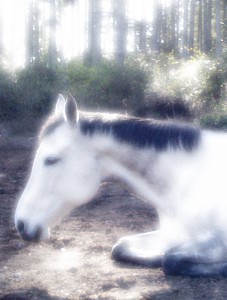 As rescuers, we often have to face the consequences of neglect upon the bodies, minds, and spirits of the horses we take in. The most obvious signs of neglect — the protruding bones, the dull coat, the sad, lifeless eyes — are usually the easiest to erase. Horses can be incredibly resilient, and time after time, we watch them come back from the brink of death and regain their health and vibrant beauty. Most will go on to lead wonderful new lives. Neglect and starvation become distant memories. And because horses are so inherently forgiving, in time they learn to trust again, and form new bonds with new people who promise a safe home for life.
As rescuers, we often have to face the consequences of neglect upon the bodies, minds, and spirits of the horses we take in. The most obvious signs of neglect — the protruding bones, the dull coat, the sad, lifeless eyes — are usually the easiest to erase. Horses can be incredibly resilient, and time after time, we watch them come back from the brink of death and regain their health and vibrant beauty. Most will go on to lead wonderful new lives. Neglect and starvation become distant memories. And because horses are so inherently forgiving, in time they learn to trust again, and form new bonds with new people who promise a safe home for life.
But some horses that we rescue can’t shake the past so easily. Some have ongoing physical effects that stem from their neglect. Others have scars that can’t be seen, but make it impossible for them to live normal lives in the company of humans or other horses. Sometimes it’s evident right from the start that a rescued horse has no chance for a decent quality of life, and in those cases, we will almost always choose a quick and merciful end to suffering by humane euthanasia. But often times, it takes quite a bit longer to recognize that a horse has long-lasting or permanent effects of neglect. Often it’s not until after they have recovered from the immediate symptoms of neglect that we begin to see the long-term consequences.
Recently we’ve been thinking a lot about hospice care. For human beings, hospice care is about providing comfort, self-respect, and tranquility in the final stage of life. It’s about minimizing pain and suffering while attending to the emotional and spiritual needs of the patient. As horse owners, we have the ability to put an immediate stop to pain and suffering in our animals through humane euthanasia. This can be a blessing when facing situations where a horse is in pain and clearly suffering. It can be quite a bit more difficult when one is considering a horse’s quality of life. A horse can be free of pain but still be miserable, particularly when the lingering effects of neglect make it difficult or impossible to lead a normal life.
Assessing a horse’s quality of life is something that we have to do fairly often, and choosing to euthanize a horse whose quality of life is poor can have a huge emotional impact on the people making the decision. It’s so easy to get overwhelmed with guilt or doubt, even when you know you are making the right choice. It’s also pretty easy to avoid making a choice at all, leaving a horse that is miserable to languish in its misery. This is why we have started to consider the idea of offering hospice care to horses whose quality of life is poor. To give them the chance to enjoy life for a period of time — a few months or even just a few weeks — before laying them to rest. We envision a horse surrounded by green grass, sunshine, and good friends. There are no grazing muzzles in hospice care, no saddles or lunge lines, and there will always be room for one more carrot. In hospice care, a horse would get to be a horse. And when the end comes, it will not be traumatic or panicked or ugly. It will be quiet and kind and dignified, surrounded by love and friends and honor and respect. It will be a far, far better alternative to misery or unhappiness, to neglect or suffering, to fear or pain.
And so we have decided to create the SAFE Hospice Program as a way to offer a respectful and dignified end to the horses in our care whose chances for a quality life have been permanently compromised. It will allow us, as rescuers, a way to find peace with the decisions we have to make, and to be able to effectively carry out our mission to help horses in truly desperate situations. Because we have limited space available at SAFE Harbor Stables, and a small amount of turnout that must be shared by several horses, our Hospice Care will take place using appropriate foster homes in our network. As always, we welcome and encourage our supporters to give us their thoughts and feedback on the work that we do.

